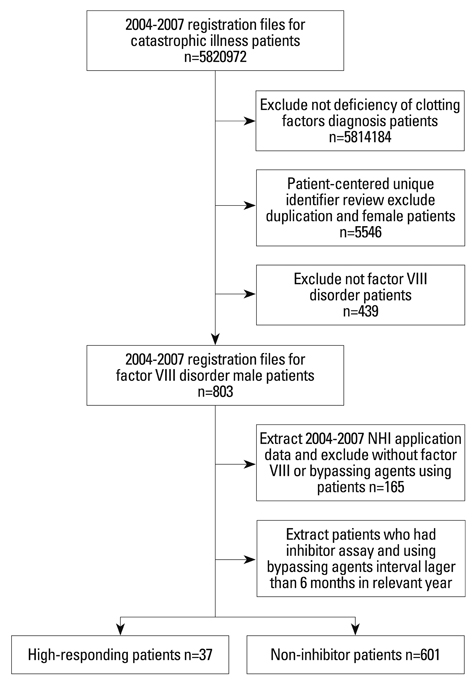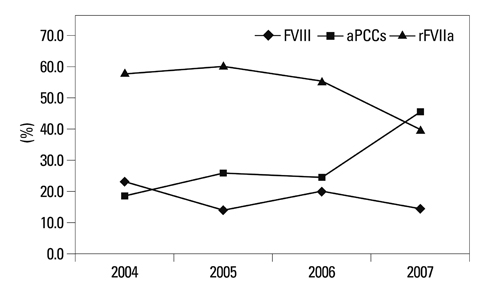Yonsei Med J.
2013 Mar;54(2):358-365. 10.3349/ymj.2013.54.2.358.
Economic Burden of High-Responding Inhibitors in Patients with Hemophilia A in Taiwan
- Affiliations
-
- 1School of Pharmacy, Kaohsiung Medical University, Kaohsiung, Taiwan, ROC. meinch@kmu.edu.tw
- 2Department of Pharmacy Practice, Tri-Service General Hospital, National Defense Medical Center, Taipei, Taiwan, ROC.
- 3The Hemophilia Care and Research Center, Tri-Service General Hospital, National Defense Medical Center, Taipei, Taiwan, ROC.
- 4Department of Pediatrics, Tri-Service General Hospital, National Defense Medical Center, Taipei, Taiwan, ROC.
- KMID: 1503897
- DOI: http://doi.org/10.3349/ymj.2013.54.2.358
Abstract
- PURPOSE
Hemophilia A (HA) is the most common X-linked inherited bleeding disorder. In some patients with HA, particularly those with severe HA, replacement therapy results in the production of high-responding clotting factor VIII inhibitors. The economic burden of this complication is the highest reported for a chronic disease. Our aim was to investigate the direct medical expenditure burden of high-responding inhibitors in patients with HA.
MATERIALS AND METHODS
A retrospective study was conducted using the National Health Insurance Research Database, utilizing data covering the period of 2004-2007.
RESULTS
In total, 638 males with HA, including 37 patients with high-responding inhibitors were evaluated. Over 99% of the annual median medical expenditure was attributable to the cost of clotting factor concentrates (CFCs) in patients with high-responding inhibitors. The annual median expenditure related to CFCs of the total medical care and outpatient care were US$170611 and US$141982, respectively, and were 4.6- and 4.3-fold higher in these patients during the study period, respectively. In patients with high-responding inhibitors, the median hospitalization expenditure and daily hospitalization cost with or without surgical procedures were 3.0- and 2.4-fold higher, respectively, and 4.3 and 5.6-fold higher, respectively.
CONCLUSION
Our data reveal higher medical expenditures burden for patients with HA and high-responding inhibitors in Taiwan. Future research is encouraged to evaluate the impact of this burden on patient quality of life.
MeSH Terms
Figure
Reference
-
1. Fischer K, Van Den Berg M. Prophylaxis for severe haemophilia: clinical and economical issues. Haemophilia. 2003. 9:376–381.
Article2. Mannucci PM, Tuddenham EG. The hemophilias--from royal genes to gene therapy. N Engl J Med. 2001. 344:1773–1779.3. Street A, Hill K, Sussex B, Warner M, Scully MF. Haemophilia and ageing. Haemophilia. 2006. 12:Suppl 3. 8–12.
Article4. Plug I, Peters M, Mauser-Bunschoten EP, de Goede-Bolder A, Heijnen L, Smit C, et al. Social participation of patients with hemophilia in the Netherlands. Blood. 2008. 111:1811–1815.
Article5. Guidelines for the management of hemophilia. 2005. accessed on 2012 October 8. Available at: http://illinoisaap.org/wp-content/uploads/guidelines-Hemophilia-WHF-2005.pdf.6. Wight J, Paisley S. The epidemiology of inhibitors in haemophilia A: a systematic review. Haemophilia. 2003. 9:418–435.
Article7. Berntorp E, Shapiro A, Astermark J, Blanchette VS, Collins PW, Dimichele D, et al. Inhibitor treatment in haemophilias A and B: summary statement for the 2006 international consensus conference. Haemophilia. 2006. 12:Suppl 6. 1–7.
Article8. Diagnosis and Management of Inhibitors to Factors VIII and IX: An Introductory Discussion for Physicians. accessed on 2011 November 15. Available at: http://www1.wfh.org/publication/files/pdf-1178.pdf.9. Globe DR, Curtis RG, Koerper MA. HUGS Steering Committee. Utilization of care in haemophilia: a resource-based method for cost analysis from the Haemophilia Utilization Group Study (HUGS). Haemophilia. 2004. 10:Suppl 1. 63–70.
Article10. Teitel J. Inhibitor economics. Semin Hematol. 2006. 43:2 Suppl 4. S14–S17.
Article11. Gringeri A, Mantovani LG, Scalone L, Mannucci PM. COCIS Study Group. Cost of care and quality of life for patients with hemophilia complicated by inhibitors: the COCIS Study Group. Blood. 2003. 102:2358–2363.
Article12. Di Minno MN, Di Minno G, Di Capua M, Cerbone AM, Coppola A. Cost of care of haemophilia with inhibitors. Haemophilia. 2010. 16:e190–e201.13. Cherishing health insurance for a healthy Taiwan. accessed on 2011 November 15. Available at: http://www.nhi.gov.tw/Resource/webdata/Attach_13792_2_cherishing.pdf.14. National Health Insurance in Taiwan 2011 Annual Report. accessed on 2012 November 15. Available at: http://www.nhi.gov.tw/Resource/webdata/13767_1_NHI%20IN%20TAIWAN%202011%20ANNUAL%20REPORT.pdf.15. Monthly Bulletin of Statistics of the Republic of China. accessed on 2011 November 15. Available at: http://eng.dgbas.gov.tw/public/data/dgbas03/bs7/bulletin_eng/PDF/eng-month10010.pdf.16. Foreign Exchange Rates. accessed on 2011 November 15. Available at: http://www.stat.gov.tw/public/data/dgbas03/bs1/handbook/bs5/p3-15.xls.17. Köhler Ulrich, Kreuter Frauke. Data Analysis Using Stata. 2005. Texas: StataCorp LP.18. Goudemand J. Hemophilia. Treatment of patients with inhibitors: cost issues. Haemophilia. 1999. 5:397–401.19. Chang H, Sher GD, Blanchette VS, Teitel JM. The impact of inhibitors on the cost of clotting factor replacement therapy in Haemophilia A in Canada. Haemophilia. 1999. 5:247–252.
Article20. Bohn RL, Aledort LM, Putnam KG, Ewenstein BM, Mogun H, Avorn J. The economic impact of factor VIII inhibitors in patients with haemophilia. Haemophilia. 2004. 10:63–68.
Article21. Ullman M, Hoots WK. Assessing the costs for clinical care of patients with high-responding factor VIII and IX inhibitors. Haemophilia. 2006. 12:Suppl 6. 74–79.
Article22. Gautier P, D'Alche-Gautier MJ, Coatmelec B, Marques-Verdier A, Bertrand MA, Dieval J, et al. Cost related to replacement therapy during hospitalization in haemophiliacs with or without inhibitors: experience of six French haemophilia centres. Haemophilia. 2002. 8:674–679.
Article23. Gringeri A, Mannucci PM. Italian Association of Haemophilia Centres. Italian guidelines for the diagnosis and treatment of patients with haemophilia and inhibitors. Haemophilia. 2005. 11:611–619.
Article24. Morfini M, Haya S, Tagariello G, Pollmann H, Quintana M, Siegmund B, et al. European study on orthopaedic status of haemophilia patients with inhibitors. Haemophilia. 2007. 13:606–612.
Article25. Soucie JM, Cianfrini C, Janco RL, Kulkarni R, Hambleton J, Evatt B, et al. Joint range-of-motion limitations among young males with hemophilia: prevalence and risk factors. Blood. 2004. 103:2467–2473.
Article
- Full Text Links
- Actions
-
Cited
- CITED
-
- Close
- Share
- Similar articles
-
- Maintenance Therapy with Activated Prothrombin Complex Concentrate (aPCC) for Hemophilia Patients with High Levels of Responding Inhibitors
- The efficacy of bypassing agents in surgery of hemophilia patients with inhibitors
- Spontaneous intramural hemorrhage in a patient with severe hemophilia A
- Long-term course of anti-factor VIII antibody in patients with hemophilia A at a single center
- Two Cases of Infant Hemophilia A Patients with Inhibitors



